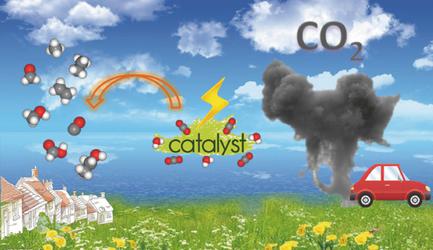Our official English website, www.x-mol.net, welcomes your
feedback! (Note: you will need to create a separate account there.)
Progress and Perspective of Electrocatalytic CO2 Reduction for Renewable Carbonaceous Fuels and Chemicals
Advanced Science ( IF 14.3 ) Pub Date : 2017-09-29 , DOI: 10.1002/advs.201700275 Wenjun Zhang 1 , Yi Hu 1 , Lianbo Ma 1 , Guoyin Zhu 1 , Yanrong Wang 1 , Xiaolan Xue 1 , Renpeng Chen 1 , Songyuan Yang 1 , Zhong Jin 1
Advanced Science ( IF 14.3 ) Pub Date : 2017-09-29 , DOI: 10.1002/advs.201700275 Wenjun Zhang 1 , Yi Hu 1 , Lianbo Ma 1 , Guoyin Zhu 1 , Yanrong Wang 1 , Xiaolan Xue 1 , Renpeng Chen 1 , Songyuan Yang 1 , Zhong Jin 1
Affiliation

|
The worldwide unrestrained emission of carbon dioxide (CO2) has caused serious environmental pollution and climate change issues. For the sustainable development of human civilization, it is very desirable to convert CO2 to renewable fuels through clean and economical chemical processes. Recently, electrocatalytic CO2 conversion is regarded as a prospective pathway for the recycling of carbon resource and the generation of sustainable fuels. In this review, recent research advances in electrocatalytic CO2 reduction are summarized from both experimental and theoretical aspects. The referred electrocatalysts are divided into different classes, including metal–organic complexes, metals, metal alloys, inorganic metal compounds and carbon‐based metal‐free nanomaterials. Moreover, the selective formation processes of different reductive products, such as formic acid/formate (HCOOH/HCOO−), monoxide carbon (CO), formaldehyde (HCHO), methane (CH4), ethylene (C2H4), methanol (CH3OH), ethanol (CH3CH2OH), etc. are introduced in detail, respectively. Owing to the limited energy efficiency, unmanageable selectivity, low stability, and indeterminate mechanisms of electrocatalytic CO2 reduction, there are still many tough challenges need to be addressed. In view of this, the current research trends to overcome these obstacles in CO2 electroreduction field are summarized. We expect that this review will provide new insights into the further technique development and practical applications of CO2 electroreduction.
中文翻译:

可再生碳质燃料和化学品电催化CO2还原的进展与展望
全球范围内无节制的二氧化碳(CO 2 )排放造成了严重的环境污染和气候变化问题。为了人类文明的可持续发展,非常希望通过清洁、经济的化学过程将CO 2转化为可再生燃料。近年来,电催化CO 2转化被认为是碳资源回收和可持续燃料生产的一条有前景的途径。本文从实验和理论两个方面对电催化CO 2还原的最新研究进展进行了综述。所提到的电催化剂分为不同的类别,包括金属有机配合物、金属、金属合金、无机金属化合物和碳基无金属纳米材料。此外,不同还原产物的选择性形成过程,如甲酸/甲酸盐(HCOOH/HCOO -)、一氧化碳(CO)、甲醛(HCHO)、甲烷(CH 4)、乙烯(C 2 H 4)、甲醇分别对(CH 3 OH)、乙醇(CH 3 CH 2 OH)等进行详细介绍。由于电催化CO 2还原的能量效率有限、选择性难以控制、稳定性低以及机制不确定,仍然存在许多严峻的挑战需要解决。鉴于此,总结了当前CO 2电还原领域克服这些障碍的研究趋势。我们期望这篇综述将为CO 2电还原的进一步技术开发和实际应用提供新的见解。
更新日期:2017-09-29
中文翻译:

可再生碳质燃料和化学品电催化CO2还原的进展与展望
全球范围内无节制的二氧化碳(CO 2 )排放造成了严重的环境污染和气候变化问题。为了人类文明的可持续发展,非常希望通过清洁、经济的化学过程将CO 2转化为可再生燃料。近年来,电催化CO 2转化被认为是碳资源回收和可持续燃料生产的一条有前景的途径。本文从实验和理论两个方面对电催化CO 2还原的最新研究进展进行了综述。所提到的电催化剂分为不同的类别,包括金属有机配合物、金属、金属合金、无机金属化合物和碳基无金属纳米材料。此外,不同还原产物的选择性形成过程,如甲酸/甲酸盐(HCOOH/HCOO -)、一氧化碳(CO)、甲醛(HCHO)、甲烷(CH 4)、乙烯(C 2 H 4)、甲醇分别对(CH 3 OH)、乙醇(CH 3 CH 2 OH)等进行详细介绍。由于电催化CO 2还原的能量效率有限、选择性难以控制、稳定性低以及机制不确定,仍然存在许多严峻的挑战需要解决。鉴于此,总结了当前CO 2电还原领域克服这些障碍的研究趋势。我们期望这篇综述将为CO 2电还原的进一步技术开发和实际应用提供新的见解。











































 京公网安备 11010802027423号
京公网安备 11010802027423号